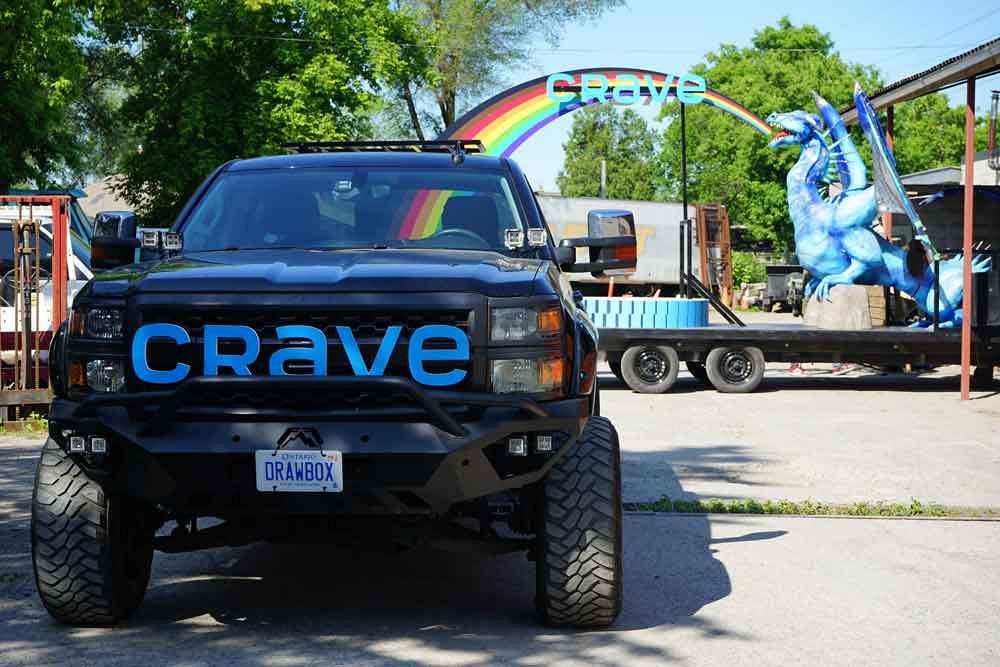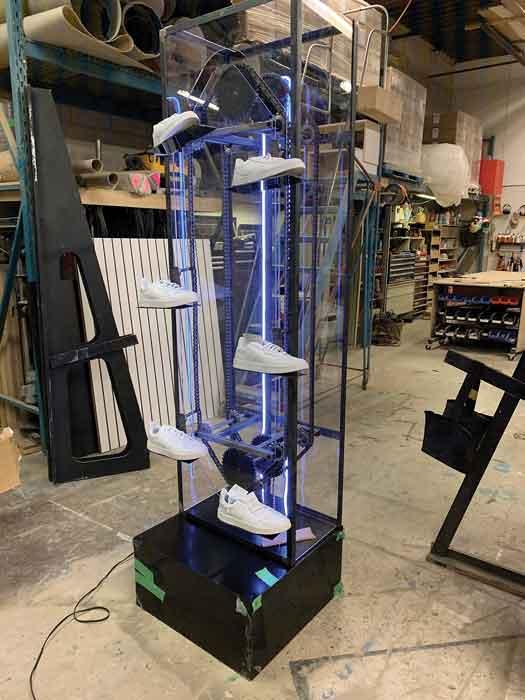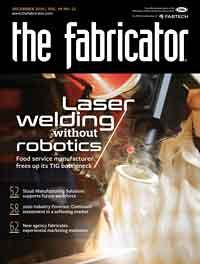Editor-in-Chief
- FMA
- The Fabricator
- FABTECH
- Canadian Metalworking
Categories
- Additive Manufacturing
- Aluminum Welding
- Arc Welding
- Assembly and Joining
- Automation and Robotics
- Bending and Forming
- Consumables
- Cutting and Weld Prep
- Electric Vehicles
- En Español
- Finishing
- Hydroforming
- Laser Cutting
- Laser Welding
- Machining
- Manufacturing Software
- Materials Handling
- Metals/Materials
- Oxyfuel Cutting
- Plasma Cutting
- Power Tools
- Punching and Other Holemaking
- Roll Forming
- Safety
- Sawing
- Shearing
- Shop Management
- Testing and Measuring
- Tube and Pipe Fabrication
- Tube and Pipe Production
- Waterjet Cutting
Industry Directory
Webcasts
Podcasts
FAB 40
Advertise
Subscribe
Account Login
Search
How to bring an experiential marketing idea to life
After opening their own fab shop, marketing mavens now can take pitches from napkin sketches to full physical fabrications
- By Dan Davis
- December 11, 2019
- Article
- Shop Management

When you see a dragon on a flatbed trailer, most people don’t think, “Who fabricated that mythical beast?” The team at drawbox Inc., Toronto, recognized that fact and created an agency that can take a marketing idea and make it a reality. Working for Crave, the Canadian video-on-demand subscription service, the agency fabricated this dragon for the 2019 Toronto Pride Parade. Photo courtesy of drawbox Inc.
You’re at a sporting event, and you hear a whirl from above during a lull in the action. You look up and see a 30-foot blimp circling above you. As you try and figure out what’s going on, a door in what looks to be the blimp’s gondola opens and starts dropping cheeseburgers attached to parachutes. You won’t forget this moment soon: The day free burgers dropped from the heavens.
Congratulations. You’ve just participated in an “experiential” marketing event. This experience made you a part of a moment, not just a passive receiver of a marketing message, like when you sit in front of the television and watch a commercial. The idea is that, because you were actively involved with the event, you won’t soon forget it—or the sponsor of the event. Perhaps you might develop some loyalty to the brand or company behind it.
This type of marketing isn’t new. Think about the many sports teams and athletes who barnstormed around the country in the early 20th century taking on all comers in exhibition matches to promote their teams and leagues, while earning some extra cash on the side. Making people a part of an event makes it more memorable.
That lesson has never been truer than today because technology has a way of including more people in these moments. The smartphone can stream a live event to make all of one’s social circle participants in it. For those that can’t join in real time, they can live vicariously through pictures and videos posted to social media channels. These marketing moments are no longer one-shot events; they live on for an indefinite time period. And depending on who is participating or sharing the moment via social media, the touchpoints can be innumerable. A marketer is certainly going to have a lot more fun working on this type of project than crunching the numbers on an advertising schedule in a trade journal.
But the thing about that print advertising is that the cost is likely to be the same from when the pitch is made to the client to when the ad buy is made. The thing about bringing an experiential marketing idea to life—from sketch to actually building and erecting the creation—is that it can get costly.
Mike Di Carlo recognized this trend after having worked in marketing agencies for close to a decade in Toronto.
“Some larger marketing agencies will develop these great concepts, but they have no idea of how it is actually built or put together. When they give their client a ballpark quote ahead of time, they really don’t know how much work is going to be required to bring that vision to reality,” Di Carlo said. “They may have to go back and let the client know that the cost is now three to four times more expensive.”
That gave Di Carlo the idea to start his own agency, but one with the expertise to physically fabricate the assemblies and structures necessary to turn these marketing pitches into memorable moments for their clients. He wanted his “shop” to be an idea creation and a fabricating facility, where everything necessary to develop a one-of-a-kind experiential marketing campaign was in-house.
Di Carlo had some general contracting experience, so he felt very comfortable with sketching out designs that would help clients visualize what was to be built. That design and building experience, as well as a willingness to dive in and learn new skills, motivated him to assemble a team and create drawbox Inc. about a year ago. The company now comprises six full-time employees, all friends and creative types willing to participate in spit-balling sessions and to roll up their sleeves if some work needs to be done.
It just happens to be one of the few agencies in the greater Toronto area with its own fab shop. Now, it’s not a large space—only about 5,000 square feet, which includes an office space and areas for metal fabricating, woodworking, and painting—but it offers enough room to accommodate about three projects at a time, Di Carlo said. Tools in the metal fabricating area include a plasma cutting table, welding power sources, and a hydraulic tube bender.

This fabricated replica of the Absolut® vodka bottle wowed drawbox’s client so much that it wanted a duplicate to be used in promotions in another province. Photo courtesy of drawbox Inc.
Many of the projects start in SketchUp, which Google owned from 2006 to 2012 before Trimble Inc. bought it. Di Carlo said it’s a convenient tool to jot down ideas and quickly present a 3D mockup of an idea. From there the sketch can be imported into SolidWorks, if the project is complicated enough, so the fabricators can have detailed drawings of what needs to be created. The DXF files then can be used to create the CNC instructions for the cutting equipment.
“I think our longest timeline to date for a project has been three weeks, from approval to final product delivery,” Di Carlo said.
Having tools to do the job is one thing. Having people who are flexible enough to take on complex projects on tight deadlines is another.
“Passion is one of the core values that drives our team. We strive to surround ourselves with people who are passionate about what they are doing, have a natural curiosity, and are willing to step outside of their comfort zones,” said
Ashley Hassard, drawbox’s vice president of client relations and general operations ringleader. “You can’t be trained to create half of what we’re being pushed to do.”
Monster of a Project
You certainly don’t go to a vocational school to fabricate a dragon, but that’s what the drawbox team did in June 2019. It was charged with creating a dragon for Crave, a Canadian subscription video-on-demand service owned by Bell Media, that would make its debut at the Toronto Pride Parade. (Crave provides subscribers with access to shows from HBO, one of the most popular of which was “Game of Thrones,” which featured the most popular dragons since H.R. Pufnstuf graced Saturday morning TV screens in the early 1970s.)
The dragon was supposed to be 12 ft. tall and 18 ft. wide and feature some movement. He wasn’t going to be able to sit on his butt and just watch the crowd for the entire parade.
The dragon’s skeleton was a steel tube structure. The drawbox team used its hydraulic tube bender to create curves in the tubes and MIG-welded the structure together. (Di Carlo estimated that about 350 ft. of steel tube was used to create the dragon.) Perforated sheet metal was then used to create the skin. It had to be hand-formed and shaped to encase the 3D structure beneath it, which ultimately led to the realistic dragon form. The company’s special effects team placed the dragon’s blue skin over the perforated metal.
To bring the dragon to life, the drawbox team designed the wings to move, providing enough movement to draw people’s attention, but not enough to get the winged beast aloft. Smoke also shot out of the nostrils periodically to complete the illusion.
“The client loved the dragon so much that they’re actually planning to use it again next year in the Montreal Pride Parade,” Hassard said.

Sometimes what fabrications lack in size, they make up for in complexity. For example, why should shoes be stationary in a shoe cabinet? Photo courtesy of drawbox Inc.
Marketing in a Bottle
Sometimes projects take on a more familiar shape. Do you recall the famous print ad campaigns for Absolut® vodka, in which the bottle or a silhouette of the bottle was front and center in each ad? Well, the company applies the same approach to its event marketing efforts.
The agency was contacted to create a 9-ft.-tall bottle for a television commercial. It had to be a heavy fabrication because it would be exposed to high winds during the commercial shoot in downtown Toronto.
For that reason, Di Carlo said his company used a ¼-in. plate to fabricate the base and steel tube for the actual tube-like structure. To aid in transporting the behemoth of a bottle, drawbox fabricators created a left and right side, so that the two sections could fit into a small shipping crate. Both sides were designed to lock into the heavy base.
A steel silhouette of a vodka bottle is easy to ignore, particularly at night. That’s why drawbox added about 400 ft. of color-changing LED lights, which can be controlled via remote control. Di Carlo said they even created a special input so that the color-changing lights could be connected to a DJ’s console, making it hard to ignore the bottle structure and the brand synonymous with it.
In this case, the client liked it enough to order two identical units that could be used in other provinces, moving them around to different bars for special promotions.
Looking Toward the Future
That type of repeat work won’t be the norm, and that’s OK with Di Carlo and his drawbox co-workers. They are excited to take on the next cheeseburger-dumping blimp project or whatever comes through the front door. Di Carlo said the company has had about 22 projects in the first six months of business, and each has been unique.
“We will continue growing as long as we love what we do every day,” he said. “That’s what it comes down to.”
The company is looking to add more projects in early 2020, and it’s eyeing a neighboring 15,000-sq.-ft. space in its industrial building for possible expansion. Di Carlo said he’s even thinking about more high-precision capital equipment, such as a laser cutting machine.
It’s been a very memorable experience since launching drawbox. The team hopes others can be a part of this same experience as it grows in the coming years.
About the Author

Dan Davis
2135 Point Blvd.
Elgin, IL 60123
815-227-8281
Dan Davis is editor-in-chief of The Fabricator, the industry's most widely circulated metal fabricating magazine, and its sister publications, The Tube & Pipe Journal and The Welder. He has been with the publications since April 2002.
subscribe now

The Fabricator is North America's leading magazine for the metal forming and fabricating industry. The magazine delivers the news, technical articles, and case histories that enable fabricators to do their jobs more efficiently. The Fabricator has served the industry since 1970.
start your free subscription- Stay connected from anywhere

Easily access valuable industry resources now with full access to the digital edition of The Fabricator.

Easily access valuable industry resources now with full access to the digital edition of The Welder.

Easily access valuable industry resources now with full access to the digital edition of The Tube and Pipe Journal.
- Podcasting
- Podcast:
- The Fabricator Podcast
- Published:
- 04/16/2024
- Running Time:
- 63:29
In this episode of The Fabricator Podcast, Caleb Chamberlain, co-founder and CEO of OSH Cut, discusses his company’s...
- Trending Articles
How to set a press brake backgauge manually

Capturing, recording equipment inspection data for FMEA

Tips for creating sheet metal tubes with perforations

Are two heads better than one in fiber laser cutting?

Hypertherm Associates implements Rapyuta Robotics AMRs in warehouse

- Industry Events
16th Annual Safety Conference
- April 30 - May 1, 2024
- Elgin,
Pipe and Tube Conference
- May 21 - 22, 2024
- Omaha, NE
World-Class Roll Forming Workshop
- June 5 - 6, 2024
- Louisville, KY
Advanced Laser Application Workshop
- June 25 - 27, 2024
- Novi, MI


























